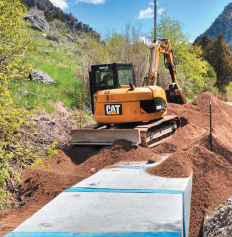October 31, 2018
CACHE WATER

Restoration Project
Cache County, Utah
DESIGN & CONSTRUCTION TEAM
General Contractor: Whitaker Construction Co.
Owner: Cache County, NRCS
Precaster: Oldcastle Infrastructure
Manufacturing Facility: Oldcastle Infrastructure, Ogden, UT
Special precast box culverts were used for one of the most significant segments of the $25.8 million emergency water restoration project, designated by the NRCS, known as the Cache Water Restoration Project (CWRP). The CWRP project involved the re-construction and improvement of approximately six miles of mostly open, unlined channels that make up the Logan and Northern, as well as the Hyde Park and Smithfield canals. The project incorporated new precast concrete pipe and box culverts, a section of pressurized pipe, metering systems, turn-outs, head gates, and improved maintenance access. The revamped Cache Valley canal system came in under budget and ahead of schedule.
CONSTRUCTION CHALLENGE
One of the key components of the project was designing the piping for the open channel section of Logan Canyon. There was uncertainty about fitting a precast, reinforced concrete box culvert into the existing canal section. This section of the canal, constructed over 100 years ago,
was basically carved into the cliffs along the canyon. At its widest, the open canal was approximately 14 feet wide with steep cliffs rising above the canal and sharp drop-offs to the state highway below. After considerable investigation, the project designers decided on concrete box culvert to solve part of the problem.
PRECAST SOLUTION
Oldcastle Infrastructure was contracted to supply approximately 10,000 linear feet of specially designed, precast concrete box culvert and precast pipe that was used in the upper portions of the canal project. Of this nearly 4,300 feet of precast box culvert was used (some 5’ x 5’ and some 6’ x 5’ to match the hydraulics of the canal) for the Logan Canyon section.
Designing a box culvert that would fit within the channel without impacting the steep slopes on either side was the challenge. To accomplish this, designers had to bevel the majority of the concrete box culvert segments so that the culvert could “snake” along the alignment, without elbows, transition vaults or closure pours.
SCOPE OF WORK
Precast Structure
- Structural Engineering
- Detailed Engineering drawings
- 5000 psi concrete
- Precast Concrete Box Culverts
Amount & Size: 4,300 feet – some 5’ x 5’ and some 6’ x 5’ to match the hydraulics of the canal
To manufacture bevels, Oldcastle Infrastructure designed and purchased new “headers” that could bevel (or angle one side of the box culvert so that a series of bevels would form a curve) up to an eight inch drop in length when measuring opposing sides of the box culvert. The joint at the end of each bevel was the same as straight box culvert sections, so that there were no extra requirements at the joints.
To fit the numerous curves in the canal alignment, beveled precast box culverts were designed in ½ inch increments with bevels ranging from ½ inch to 8 inches. The bevels had to be specifically designed as “curve to the left” or “curve to the right” and each piece of box culvert had to be numbered and installed in a series so that the box culvert did not deviate from the alignment. After emerging from Logan Canyon, the water is transferred from the box culvert to a 66 inch concrete pipeline that heads north.
Whitaker Construction installed each section so that the inner joint gap measured 1/2”. Once the alignment was established, the installation progressed rapidly with the contractor averaging over 15 sections per day. This was a record rate of installation when considering winter conditions and that only one access to the upper section of the project existed, so the box culvert and its bedding materials had to be transported 3,000 feet along the canal at the start of the section.
The box culvert was backfilled with 6 inches of road base to provide for a maintenance access road and a recreational trail. The top of the box culvert is now gated at both ends and can be used for maintenance as well as access by the U.S. Forest Service. “The canal operators used to have to drive a truck in the channel to do maintenance like removing rocks. The box culvert eliminates that problem. We’ve built an access road on top of the box culvert with openings for access,” said Zan Murray, from the Logan office of project manager J-U-B Engineering, in the June Issue article of Utah Construction & Design.
While the project requirements were difficult enough, the construction schedule started in October of 2012 with the irrigation facilities required to be operational by May of 2013. When operators opened the new facilities in 2013 they were amazed by how much water savings had been achieved with the addition of concrete box culvert and pipe. Early reports indicated that flow metering showed almost no water loss over two miles of concrete culvert and concrete pipe. While 2013 was a difficult water year, with many areas of Utah on water restriction, the Cache Valley irrigators were able to have water throughout the growing season
The revamped Cache Valley canal system came in under budget and ahead of schedule.
Find out more about Oldcastle Infrastructure Concrete Culvert Products.